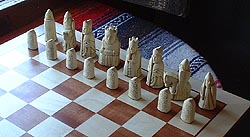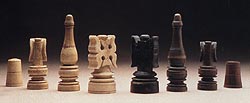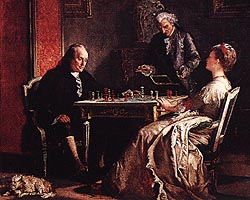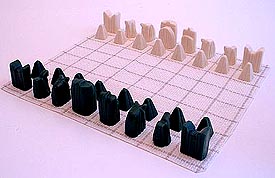An Illustrated History of Chess
Contents:
1 Origins
2 Early Chess
3 Thailand, Burma
4 China
5 From China?
6 Korea
7 Japan
8 Evolution
9 Europe
10 Variants
Exotic Chess
Products
The History
of Chess
How
To Play
Chess from
Around the World
An Illustrated History of Chess_________________9____
Chess has seen countless variations throughout its evolution. It has been expanded to enormous boards, pieces have been added, new moves have been devised and new identities have been given to the pieces. One
great European variant, Courier Chess lasted for some 600 years
— longer than modern chess has existed so far.
|
|
These
chess sets would have been played by the same rules —
the rules of ancient chess. |
Yet
the chess which came to Europe from Asia, passing from one culture
to another, remained virtually unchanged for almost a millenium.
Even as pieces changed shape and identity, the rules of the game
remained remarkably stable.

|
| But somehow, a new chess took hold. The best evidence places the change in northern Italy and Spain, right at the end of the 15th century. The first known printed occurance of the new rules is dated 1497 — but that manuscript seems to indicate that the new game was already generally known. |  These pieces, of the later Scandinavian design, circa 12th century, would also have been played using the old rules. |
 This famous chess set, from mid 15th century Italy, probably began its life playing the ancient chess, but later learned the rules of the new game.  The set came with a very elaborate board. |
It was called the new chess, the queen's chess, or chess of the mad queen, and it spread like wildfire throughout Europe. Within one generation the chess which had endured centuries and had covered half of the known world was eclipsed in most of Europe by the new game. The old game became a relic, an anachronism remembered by monks and academics — those who clung to the old chess literature which was suddenly obsolete. |
| What
were the new rules? Most astonishing as that the queen had unprecedented
new power, dominating the board with the ability to move any number
of spaces forward, backward, left, right or diagonally. The bishop, at the same time, was given the power to move along the complete diagonal, and the pawn was given the power to take two spaces in its first move. Castling and en passant capture followed quickly, and a new chess was born. |
 The great American statesman, Ben Franklin, playing chess as we know it, about 280 years after the new rules took effect. He is playing here on pieces of the Régence design. |
The
new chess,
|
HOME
PAGE CHESS PRODUCTS: International | Asian | Reproductions | Unique | Rare | Other Games CHESS HISTORY PAGES: 1 | 2 | 3 | 4 | 5 | 6 | 7 | 8 | 9 | 10 HOW TO PLAY: Chess | Courier Chess | Sittuyin | Xiangqi | Shogi | Shatranj | Janggi Makruk | Shatar | Dou Shou Qi | Luzhanqi LINKS: Chess Variants | Chess History | Chess Articles | Mah Jongg AFFILIATED SITES: Rick Knowlton | Courier Chess | Knowlton Mosaics Ken Knowlton | Insite Age | VerySpecial.us CONTACT US |


